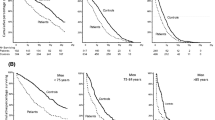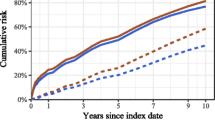Abstract
Summary
We evaluated the long-term excess mortality associated with hip fracture, using prospectively collected data on pre-fracture health and function from a nationally representative sample of U.S. elders. Although mortality was elevated for the first six months following hip fracture, we found no evidence of long-term excess mortality.
Introduction
The long-term excess mortality associated with hip fracture remains controversial.
Methods
To assess the association between hip fracture and mortality, we used prospectively collected data on pre-fracture health and function from a representative sample of U.S. elders in the Medicare Current Beneficiary Survey (MCBS) to perform survival analyses with time-varying covariates.
Results
Among 25,178 MCBS participants followed for a median duration of 3.8 years, 730 sustained a hip fracture during follow-up. Both early (within 6 months) and subsequent mortality showed significant elevations in models adjusted only for age, sex and race. With additional adjustment for pre-fracture health status, functional impairments, comorbid conditions and socioeconomic status, however, increased mortality was limited to the first six months after fracture (hazard ratio [HR]: 6.28, 95% CI: 4.82, 8.19). No increased mortality was evident during subsequent follow-up (HR: 1.04, 95% CI: 0.88, 1.23). Hip-fracture-attributable population mortality ranged from 0.5% at age 65 among men to 6% at age 85 among women.
Conclusions
Hip fracture was associated with substantially increased mortality, but much of the short-term risk and all of the long-term risk was explained by the greater frailty of those experiencing hip fracture.



Similar content being viewed by others
References
Melton LJ III (2003) Adverse outcomes of osteoporotic fractures in the general population. J Bone Miner Res 18:1139–1141
Vanness D, Tosteson, A (2005) Estimating the opportunity costs of osteoporosis in the United States. Topics Geriatric Rehab 21:4–16
Office of the Surgeon General (2004) Bone health and osteoporosis: A report of the surgeon general. U.S. Department of Health and Human Services, Rockville, MD
Kanis JA, Borgstrom F, Zethraeus N, Johnell O, Oden A, Jönsson B (2005) Intervention thresholds for osteoporosis in the UK. Bone 36:22–32
Kanis JA, Johnell O, Oden A, Borgstrom F, Johansson H, De Laet C, Jönsson B (2005) Intervention thresholds for osteoporosis in men and women: a study based on data from Sweden. Osteoporos Int 16:6–14
Tosteson AN, Jönsson B, Grima DT, O’Brien BJ, Black DM, Adachi JD (2001) Challenges for model-based economic evaluations of postmenopausal osteoporosis interventions. Osteoporos Int 12:849–857
Melton LJ 3rd, Therneau TM, Larson DR (1998) Long-term trends in hip fracture prevalence: the influence of hip fracture incidence and survival. Osteoporos Int 8:68–74
Magaziner J, Lydick E, Hawkes W, Fox KM, Zimmerman SI, Epstein RS, Hebel JR (1997) Excess mortality attributable to hip fracture in white women aged 70 years and older. Am J Public Health 87:1630–1636
Wolinsky FD, Fitzgerald JF, Stump TE (1997) The effect of hip fracture on mortality, hospitalization, and functional status: a prospective study. Am J Public Health 87:398–403
Kanis JA, Oden A, Johnell O, De Laet C, Jönsson B, Oglesby AK (2003) The components of excess mortality after hip fracture. Bone 32:468–473
Johnell O, Kanis JA (2004) An estimate of the worldwide prevalence, mortality and disability associated with hip fracture. Osteoporos Int 15:897–902
Empana JP, Dargent-Molina P, Breart G (2004) Effect of hip fracture on mortality in elderly women: the EPIDOS prospective study. J Am Geriatr Soc 52:685–690
Richmond J, Aharonoff GB, Zuckerman JD, Koval KJ (2003) Mortality risk after hip fracture. J Orthop Trauma 17:53–56
Cauley JA, Thompson DE, Ensrud KC, Scott JC, Black D (2000) Risk of mortality following clinical fractures. Osteoporos Int 11:556–561
Forsen L, Sogaard AJ, Meyer HE, Edna T, Kopjar B (1999) Survival after hip fracture: short- and long-term excess mortality according to age and gender. Osteoporos Int 10:73–78
Zuckerman JD (1996) Hip fracture. N Engl J Med 334:1519–1525
Johnell O, Kanis JA, Oden A, Sernbo I, Redlund-Johnell I, Petterson C, De Laet C, Jönsson B (2004) Mortality after osteoporotic fractures. Osteoporos Int 15:38–42
Browner WS, Pressman AR, Nevitt MC, Cummings SR (1996) Mortality following fractures in older women. The study of osteoporotic fractures. Arch Intern Med 156:1521–1525
Poor G, Atkinson EJ, O’Fallon WM, Melton LJ 3rd (1995) Determinants of reduced survival following hip fractures in men. Clin Orthop Relat Res 260–265
Centers for Medicare and Medicaid Services. Medicare Current Beneficiary Survey (MCBS). Available at http://www.cms.hhs.gov/MCBS/ (21 Sept. 2006)
Kautter J, Khatutsky G, Pope GC, Chromy JR, Adler GS (2006) Impact of nonresponse on medicare current beneficiary survey estimates. Health Care Financ Rev 27:71–93
Adler GS (1994) A profile of the medicare current beneficiary survey. Health Care Financ Rev 15:153–163
Iezzoni LI, Shwartz M, Moskowitz MA, Ash AS, Sawitz E, Burnside S (1990) Illness severity and costs of admissions at teaching and nonteaching hospitals. JAMA 264:1426–1431
Centers for Medicare and Medicaid Services. Appendix A. Technical Documentation for the Medicare Current Beneficiary Survey. 2006. Available at http://www.cms.hhs.gov/MCBS/Downloads/HHC_1994_appendixA.pdf
Benichou J (2001) A review of adjusted estimators of attributable risk. Stat Methods Med Res 10:195–216
Melton LJ 3rd, Crowson CS, O’Fallon WM (1999) Fracture incidence in Olmsted County, Minnesota: comparison of urban with rural rates and changes in urban rates over time. Osteoporos Int 9:29–37
Arias E (2004) United States life tables, 2001. In National vital statistics reports. National Center for Health Statistics, Hyattsville, MD
Miller CW (1978) Survival and ambulation following hip fracture. J Bone Joint Surg Am 60:930–934
Dahl E (1980) Mortality and life expectancy after hip fractures. Acta Orthop Scand 51:163–170
Kreutzfeldt J, Haim M, Bach E (1984) Hip fracture among the elderly in a mixed urban and rural population. Age Ageing 13:111–119
Farahmand BY, Michaelsson K, Ahlbom A, Ljunghall S, Baron JA (2005) Survival after hip fracture. Osteoporos Int 16:1583–1590
Trombetti A, Herrmann F, Hoffmeyer P, Schurch MA, Bonjour JP, Rizzoli R (2002) Survival and potential years of life lost after hip fracture in men and age-matched women. Osteoporos Int 13:731–737
Center JR, Nguyen TV, Schneider D, Sambrook PN, Eisman JA (1999) Mortality after all major types of osteoporotic fracture in men and women: an observational study. Lancet 353:878–882
Meyer HE, Tverdal A, Falch JA, Pedersen JI (2000) Factors associated with mortality after hip fracture. Osteoporos Int 11:228–232
Moran CG, Wenn RT, Sikand M, Taylor AM (2005) Early mortality after hip fracture: is delay before surgery important? J Bone Joint Surg Am 87:483–489
Weller I, Wai EK, Jaglal S, Kreder HJ (2005) The effect of hospital type and surgical delay on mortality after surgery for hip fracture. J Bone Joint Surg Br 87:361–366
Orosz GM, Magaziner J, Hannan EL, Morrison RS, Koval K, Gilbert M, McLaughlin M, Halm EA, Wang JJ, Litke A, Silberzweig SB, Siu AL (2004) Association of timing of surgery for hip fracture and patient outcomes. JAMA 291:1738–1743
Cornwall R, Gilbert MS, Koval KJ, Strauss E, Siu AL (2004) Functional outcomes and mortality vary among different types of hip fractures: a function of patient characteristics. Clin Orthop Relat Res 64–71
Jensen JS, Tondevold E (1979) Mortality after hip fractures. Acta Orthop Scand 50:161–167
Fransen M, Woodward M, Norton R, Robinson E, Butler M, Campbell AJ (2002) Excess mortality or institutionalization after hip fracture: men are at greater risk than women. J Am Geriatr Soc 50:685–690
Wehren LE, Hawkes WG, Orwig DL, Hebel JR, Zimmerman SI, Magaziner J (2003) Gender differences in mortality after hip fracture: the role of infection. J Bone Miner Res 18:2231–2237
Jacobsen SJ, Goldberg J, Miles TP, Brody JA, Stiers W, Rimm AA (1992) Race and sex differences in mortality following fracture of the hip. Am J Public Health 82:1147–1150
Robbins JA, Biggs ML, Cauley J (2006) Adjusted mortality after hip fracture: From the cardiovascular health study. J Am Geriatr Soc 54:1885–1891
Fisher ES, Baron JA, Malenka DJ, Barrett JA, Kniffin WD, Whaley FS, Bubolz TA (1991) Hip fracture incidence and mortality in New England. Epidemiology 2:116–122
Acknowledgments
This study was supported by NIH grant AG12262, U.S. Public Health Service. The authors thank Ms. Loretta Pearson for editorial assistance and a comprehensive literature review and Ms. Margaret Grove for assistance with figure preparation.
Author information
Authors and Affiliations
Corresponding author
Appendix
Appendix
Rights and permissions
About this article
Cite this article
Tosteson, A.N.A., Gottlieb, D.J., Radley, D.C. et al. Excess mortality following hip fracture: the role of underlying health status. Osteoporos Int 18, 1463–1472 (2007). https://doi.org/10.1007/s00198-007-0429-6
Received:
Accepted:
Published:
Issue Date:
DOI: https://doi.org/10.1007/s00198-007-0429-6




